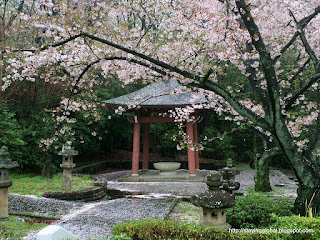The best part about living in Nagoya is that despite being Japan's 3rd largest city (and also the 4th most populated city), one doesn't get the feel of being in a concrete jungle. Nagoya, a busy port city and manufacturing hub in central Japan. Barring the business districts near Nagoya station, Marunouchi, Sakae and a couple of other neighborhoods, Nagoya has lots of open spaces and public parks.
One such neighborhood is the area around the Higashiyama Koen Station in the city's Chikusa ward. Just outside the station on the city's Higashiyama subway line is the Higashiyama Zoo and Botanical Gardens. The zoo is one of the oldest and largest in Japan and right in the middle of the city !
A short walk from the Higashiyama Zoo is the Heiwa Koen, a large park close to the Heiwa cemetery.
The park is dedicated to the memory of victims of World War II.
In the 150 hectare public park are various walking trails, open spaces where people can relax and enjoy picnics and barbecues and children can play freely.
At one end of the park is the Nekogahora ike, a pond said to have existed since the 17th century.
The park also features the Heiwa do, a Chinese style peace hall monument, a gift from Nagoya's sister city Nanjing.
A statue of the Buddha is enshrined in the Heiwa do.
Nearby is the Niji-no-toh (Rainbow tower).
On the Vernal and Autumnal Equinox days the sunlight on top of the tower reflects rainbow colors on the ground.
The hill top location of Heiwa-do overlooks the Heiwa park and a large part of Nagoya city.
The JR Nagoya towers, Midland square and other skyscrapers in the city's central Naka district can be seen in the distance in the picture above.
While the park is visited by locals all through the year, it draws large number of visitors in the Cherry Blossom season in spring. There are about 2250 trees of various kinds of ornamental cherry trees.
It is less crowded compared to the most popular Tsuruma park. Unlike the other popular 'Hanami' spots, there is no illumination at night so the park is best visited during daytime.
There are various kinds of maple trees, Azaleas, Japanese pines, eucalyptus, magnolia and other trees in the park.
No wonder various kinds of birds can be seen in the park. Photographers can be seen in the park patiently waiting to capture images of various colorful birds.
Access: 15 minutes walking from the Higashiyama Koen and Hoshigaoka stations on the
Higashiyama subway line and Jiyugaoka station on the Meijo line.
City buses ply from the Hoshigaoka bus terminal ( bound for Jiyugaoka) and stop
at Heiwa Koen stop.
Parking: Free parking is available at the park
Entrance: Free
Opening days: Always open
One such neighborhood is the area around the Higashiyama Koen Station in the city's Chikusa ward. Just outside the station on the city's Higashiyama subway line is the Higashiyama Zoo and Botanical Gardens. The zoo is one of the oldest and largest in Japan and right in the middle of the city !
A short walk from the Higashiyama Zoo is the Heiwa Koen, a large park close to the Heiwa cemetery.
The park is dedicated to the memory of victims of World War II.
In the 150 hectare public park are various walking trails, open spaces where people can relax and enjoy picnics and barbecues and children can play freely.
At one end of the park is the Nekogahora ike, a pond said to have existed since the 17th century.
The park also features the Heiwa do, a Chinese style peace hall monument, a gift from Nagoya's sister city Nanjing.
A statue of the Buddha is enshrined in the Heiwa do.
Nearby is the Niji-no-toh (Rainbow tower).
On the Vernal and Autumnal Equinox days the sunlight on top of the tower reflects rainbow colors on the ground.
The hill top location of Heiwa-do overlooks the Heiwa park and a large part of Nagoya city.
The JR Nagoya towers, Midland square and other skyscrapers in the city's central Naka district can be seen in the distance in the picture above.
While the park is visited by locals all through the year, it draws large number of visitors in the Cherry Blossom season in spring. There are about 2250 trees of various kinds of ornamental cherry trees.
It goes without saying that Heiwa koen is one of Nagoya's popular 'Hanami' spots. For those unaware of the term 'Hanami', it is the Japanese tradition of enjoying picnics and parties under cherry blossoms.
We visited the park very early in the morning and we saw people had reserved their hanami spot and waiting for the rest of their group to arrive perhaps a few hours later! It is less crowded compared to the most popular Tsuruma park. Unlike the other popular 'Hanami' spots, there is no illumination at night so the park is best visited during daytime.
There are various kinds of maple trees, Azaleas, Japanese pines, eucalyptus, magnolia and other trees in the park.
No wonder various kinds of birds can be seen in the park. Photographers can be seen in the park patiently waiting to capture images of various colorful birds.
Access: 15 minutes walking from the Higashiyama Koen and Hoshigaoka stations on the
Higashiyama subway line and Jiyugaoka station on the Meijo line.
City buses ply from the Hoshigaoka bus terminal ( bound for Jiyugaoka) and stop
at Heiwa Koen stop.
Parking: Free parking is available at the park
Entrance: Free
Opening days: Always open


















No comments:
Post a Comment